2004 CHEVROLET TAHOE trailer
[x] Cancel search: trailerPage 364 of 556

Steps for Determining Correct Load Limit
1. Locate the statement “The combined weight of
occupants and cargo should never exceed XXX
pounds” on your vehicle placard.
2. Determine the combined weight of the driver and
passengers that will be riding in your vehicle.
3. Subtract the combined weight of the driver and
passengers from XXX kilograms or XXX pounds.
4. The resulting �gure equals the available amount of
cargo and luggage load capacity. For example, if the
“XXX” amount equals 1400 lbs. and there will be �ve
150 lb. passengers in your vehicle, the amount of
available cargo and luggage load capacity is 650 lbs.
(1400−750 (5 x 150) = 650 lbs.).
5. Determine the combined weight of luggage and
cargo being loaded on the vehicle. That weight
may not safely exceed the available cargo
and luggage load capacity calculated in Step 4.
6. If your vehicle will be towing a trailer, the load from
your trailer will be transferred to your vehicle.
Consult this manual to determine how this reduces
the available cargo and luggage load capacity of
your vehicle.
SeeTowing a Trailer on page 4-65for more
information on towing a trailer, towing safety rules
and trailering tips.
Loading Your Vehicle
Item Description Total
AVehicle Capacity Weight
for Example 1=1,000 lbs
(453 kg)
BSubtract Occupant
Weight 150 lbs
(68 kg)×2=300 lbs (136 kg)
CAvailable Occupant and
Cargo Weight =700 lbs. (317 kg) Example 1
4-60
Page 368 of 556
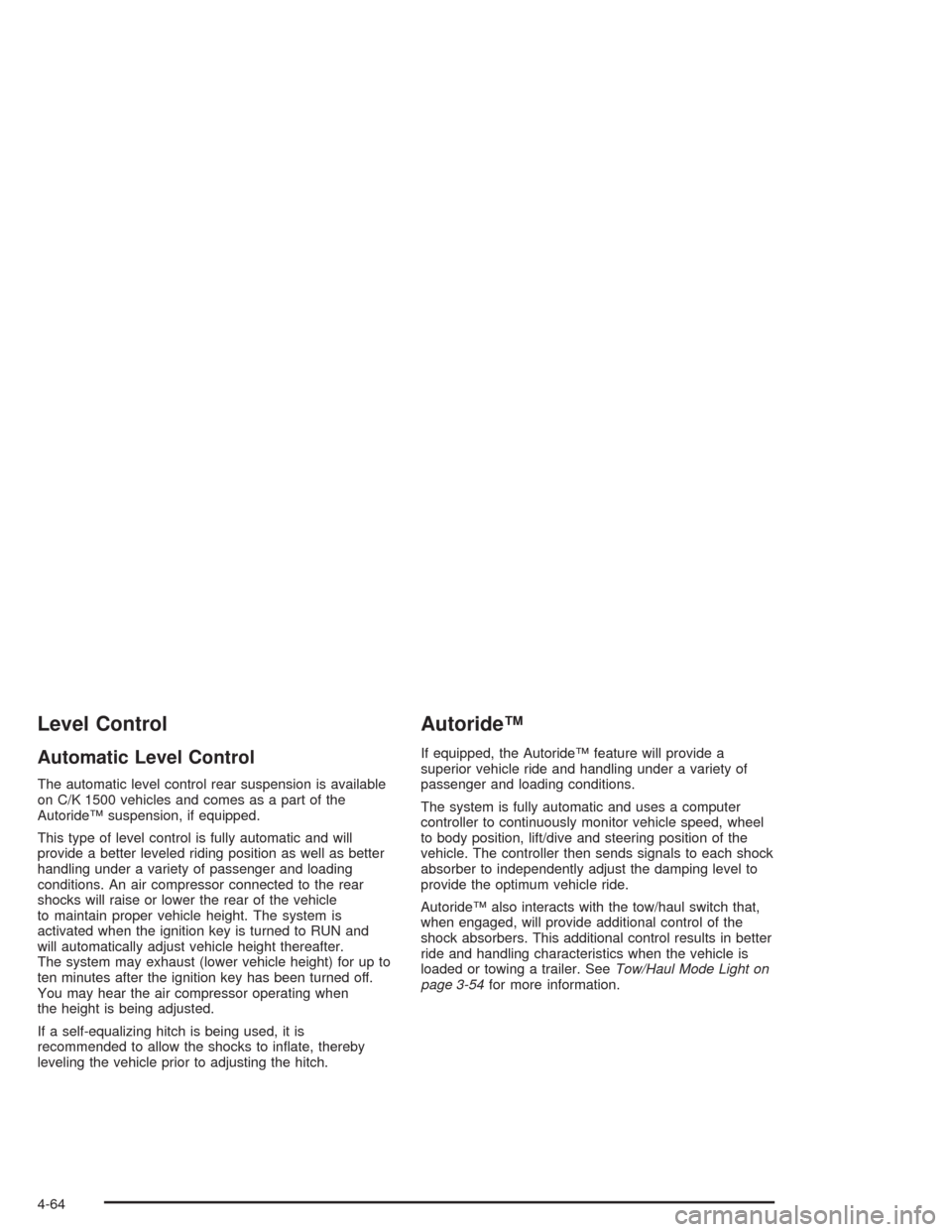
Level Control
Automatic Level Control
The automatic level control rear suspension is available
on C/K 1500 vehicles and comes as a part of the
Autoride™ suspension, if equipped.
This type of level control is fully automatic and will
provide a better leveled riding position as well as better
handling under a variety of passenger and loading
conditions. An air compressor connected to the rear
shocks will raise or lower the rear of the vehicle
to maintain proper vehicle height. The system is
activated when the ignition key is turned to RUN and
will automatically adjust vehicle height thereafter.
The system may exhaust (lower vehicle height) for up to
ten minutes after the ignition key has been turned off.
You may hear the air compressor operating when
the height is being adjusted.
If a self-equalizing hitch is being used, it is
recommended to allow the shocks to in�ate, thereby
leveling the vehicle prior to adjusting the hitch.
Autoride™
If equipped, the Autoride™ feature will provide a
superior vehicle ride and handling under a variety of
passenger and loading conditions.
The system is fully automatic and uses a computer
controller to continuously monitor vehicle speed, wheel
to body position, lift/dive and steering position of the
vehicle. The controller then sends signals to each shock
absorber to independently adjust the damping level to
provide the optimum vehicle ride.
Autoride™ also interacts with the tow/haul switch that,
when engaged, will provide additional control of the
shock absorbers. This additional control results in better
ride and handling characteristics when the vehicle is
loaded or towing a trailer. SeeTow/Haul Mode Light on
page 3-54for more information.
4-64
Page 369 of 556
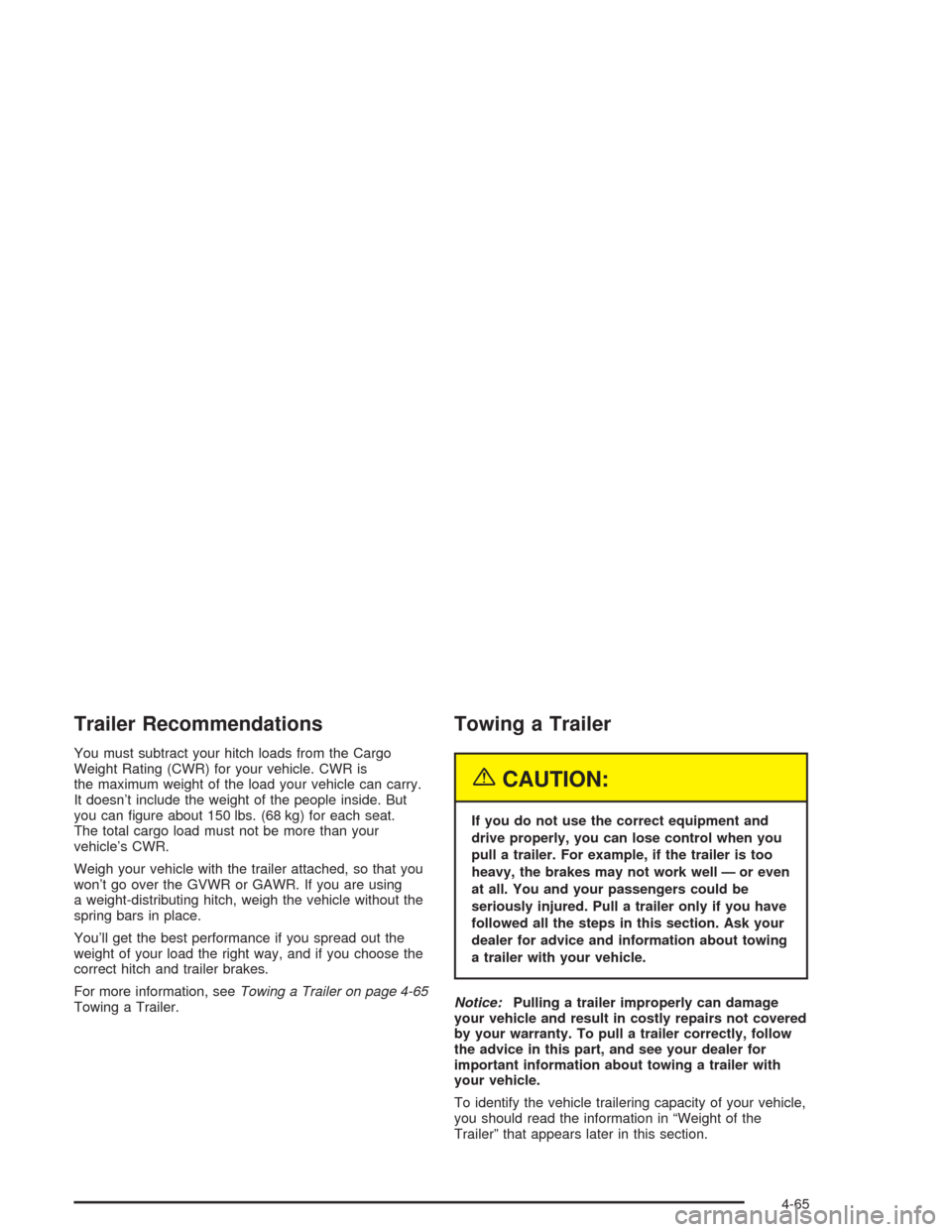
Trailer Recommendations
You must subtract your hitch loads from the Cargo
Weight Rating (CWR) for your vehicle. CWR is
the maximum weight of the load your vehicle can carry.
It doesn’t include the weight of the people inside. But
you can �gure about 150 lbs. (68 kg) for each seat.
The total cargo load must not be more than your
vehicle’s CWR.
Weigh your vehicle with the trailer attached, so that you
won’t go over the GVWR or GAWR. If you are using
a weight-distributing hitch, weigh the vehicle without the
spring bars in place.
You’ll get the best performance if you spread out the
weight of your load the right way, and if you choose the
correct hitch and trailer brakes.
For more information, seeTowing a Trailer on page 4-65
Towing a Trailer.
Towing a Trailer
{CAUTION:
If you do not use the correct equipment and
drive properly, you can lose control when you
pull a trailer. For example, if the trailer is too
heavy, the brakes may not work well — or even
at all. You and your passengers could be
seriously injured. Pull a trailer only if you have
followed all the steps in this section. Ask your
dealer for advice and information about towing
a trailer with your vehicle.
Notice:Pulling a trailer improperly can damage
your vehicle and result in costly repairs not covered
by your warranty. To pull a trailer correctly, follow
the advice in this part, and see your dealer for
important information about towing a trailer with
your vehicle.
To identify the vehicle trailering capacity of your vehicle,
you should read the information in “Weight of the
Trailer” that appears later in this section.
4-65
Page 370 of 556

If yours was built with trailering options, as many are,
it’s ready for heavier trailers. But trailering is different
than just driving your vehicle by itself. Trailering means
changes in acceleration, braking, handling, durability
and fuel economy. Successful, safe trailering takes
correct equipment, and it has to be used properly.
That’s the reason for this part. In it are many time-tested,
important trailering tips and safety rules. Many of
these are important for your safety and that of your
passengers. So please read this section carefully before
you pull a trailer.
If You Do Decide To Pull A Trailer
If you do, here are some important points:
There are many different laws, including speed limit
restrictions, having to do with trailering. Make sure
your rig will be legal, not only where you live
but also where you’ll be driving. A good source for
this information can be state or provincial police.
Consider using a sway control. See “Hitches” later
in this section.
Don’t tow a trailer at all during the �rst 500 miles
(800 km) your new vehicle is driven. Your engine,
axle or other parts could be damaged.
Then, during the �rst 500 miles (800 km) that you
tow a trailer, don’t drive over 50 mph (80 km/h)
and don’t make starts at full throttle. This helps your
engine and other parts of your vehicle wear in at
the heavier loads.
You can tow in DRIVE (D). You may want to shift
the transmission to THIRD (3) or, if necessary, a
lower gear selection if the transmission shifts
too often (e.g., under heavy loads and/or hilly
conditions). See “Tow/Haul Mode” later in
this section.
Three important considerations have to do with weight:
The weight of the trailer
The weight of the trailer tongue
The weight on your vehicle’s tires
4-66
Page 371 of 556

Tow/Haul Mode
Tow/Haul is a feature that assists when pulling a heavy
trailer or a large or heavy load. The purpose of the
Tow/Haul mode is to:
Reduce the frequency and improve the predictability
of transmission shifts when pulling a heavy trailer or
a large or heavy load.
Provide the same solid shift feel when pulling a
heavy trailer or a large or heavy load as when
the vehicle is unloaded.
Improve control of vehicle speed while requiring
less throttle pedal activity when pulling a heavy
trailer or a large or heavy load.
Your vehicle may be equipped with a button at the end
of the shift lever which, when pressed, enables
tow/haul. Your vehicle may be equipped with
Autoride™
®which further improves your vehicle’s ride
while towing. SeeAutoride™ on page 4-64for more
information. When the button is pressed, a light on the
instrument panel will illuminate to indicate that
Tow/Haul has been selected. Tow/Haul may be turned
off by pressing the button again, at which time the
indicator light on the instrument panel will turn off. The
vehicle will automatically turn off Tow/Haul every
time it is started.Tow/Haul is designed to be most effective when the
vehicle and trailer combined weight is at least 75% of
the vehicle’s Gross Combined Weight Rating (GCWR).
See Weight of the Trailer later in this section.
Tow/Haul is most useful under the following driving
conditions:
When pulling a heavy trailer or a large or heavy
load through rolling terrain.
When pulling a heavy trailer or a large or heavy
load in stop and go traffic.
When pulling a heavy trailer or a large or heavy
load in busy parking lots where improved low
speed control of the vehicle is desired.
Operating the vehicle in tow/haul when lightly loaded or
with no trailer at all will not cause damage. However,
there is no bene�t to the selection of Tow/Haul when the
vehicle is unloaded. Such a selection when unloaded
may result in unpleasant engine and transmission driving
characteristics and reduced fuel economy. Tow/Haul
is recommended only when pulling a heavy trailer or a
large or heavy load.
4-67
Page 372 of 556
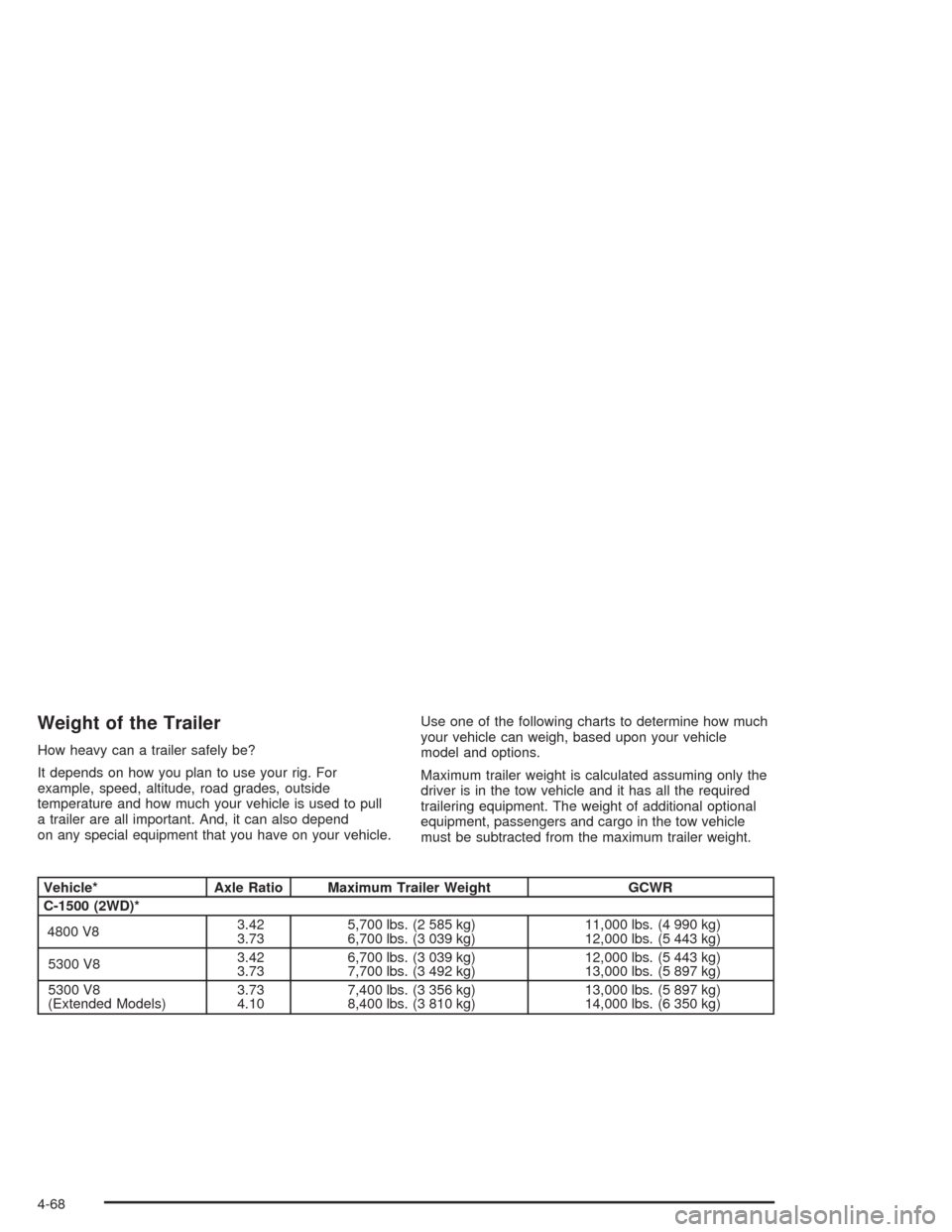
Weight of the Trailer
How heavy can a trailer safely be?
It depends on how you plan to use your rig. For
example, speed, altitude, road grades, outside
temperature and how much your vehicle is used to pull
a trailer are all important. And, it can also depend
on any special equipment that you have on your vehicle.Use one of the following charts to determine how much
your vehicle can weigh, based upon your vehicle
model and options.
Maximum trailer weight is calculated assuming only the
driver is in the tow vehicle and it has all the required
trailering equipment. The weight of additional optional
equipment, passengers and cargo in the tow vehicle
must be subtracted from the maximum trailer weight.
Vehicle* Axle Ratio Maximum Trailer Weight GCWR
C-1500 (2WD)*
4800 V83.42
3.735,700 lbs. (2 585 kg)
6,700 lbs. (3 039 kg)11,000 lbs. (4 990 kg)
12,000 lbs. (5 443 kg)
5300 V83.42
3.736,700 lbs. (3 039 kg)
7,700 lbs. (3 492 kg)12,000 lbs. (5 443 kg)
13,000 lbs. (5 897 kg)
5300 V8
(Extended Models)3.73
4.107,400 lbs. (3 356 kg)
8,400 lbs. (3 810 kg)13,000 lbs. (5 897 kg)
14,000 lbs. (6 350 kg)
4-68
Page 373 of 556
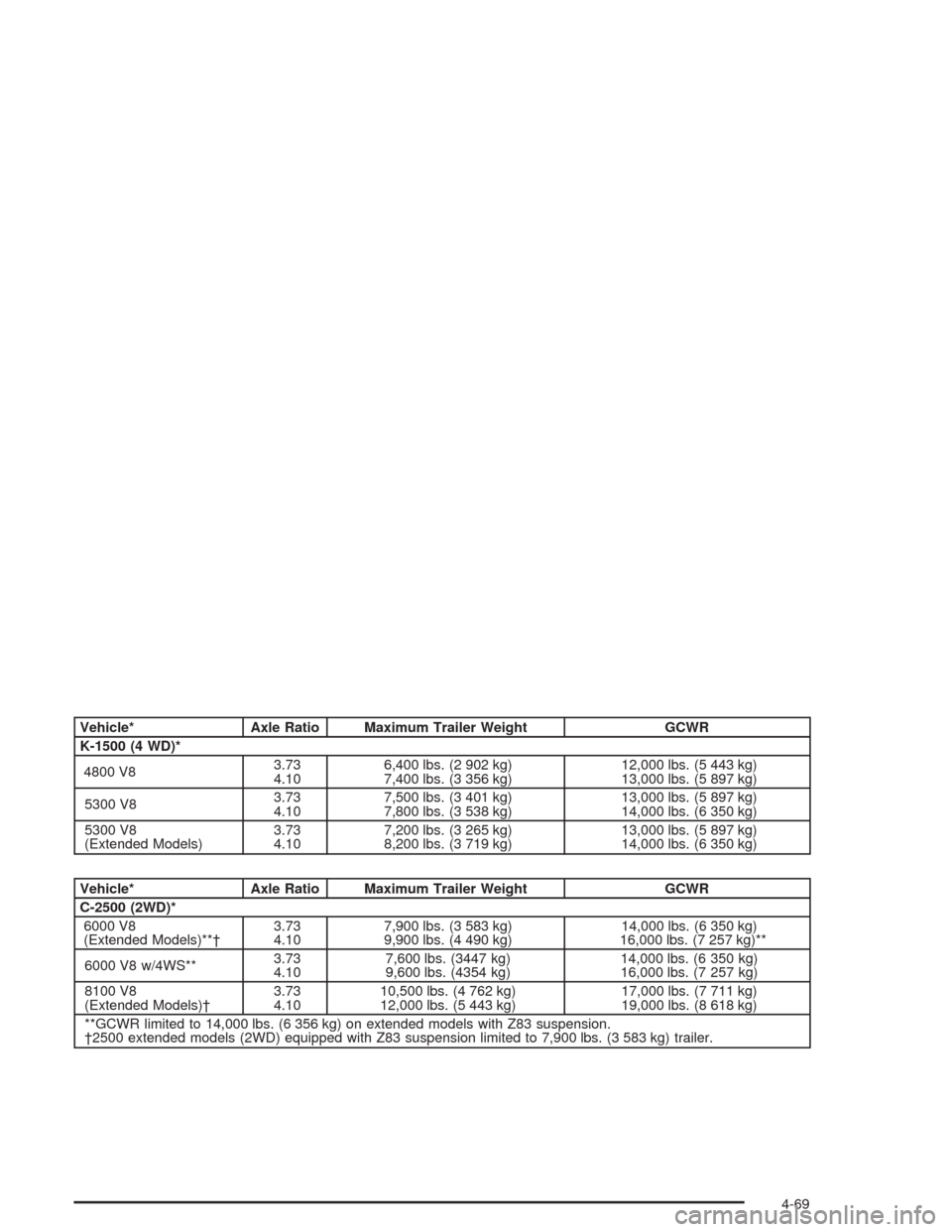
Vehicle* Axle Ratio Maximum Trailer Weight GCWR
K-1500 (4 WD)*
4800 V83.73
4.106,400 lbs. (2 902 kg)
7,400 lbs. (3 356 kg)12,000 lbs. (5 443 kg)
13,000 lbs. (5 897 kg)
5300 V83.73
4.107,500 lbs. (3 401 kg)
7,800 lbs. (3 538 kg)13,000 lbs. (5 897 kg)
14,000 lbs. (6 350 kg)
5300 V8
(Extended Models)3.73
4.107,200 lbs. (3 265 kg)
8,200 lbs. (3 719 kg)13,000 lbs. (5 897 kg)
14,000 lbs. (6 350 kg)
Vehicle* Axle Ratio Maximum Trailer Weight GCWR
C-2500 (2WD)*
6000 V8
(Extended Models)**†3.73
4.107,900 lbs. (3 583 kg)
9,900 lbs. (4 490 kg)14,000 lbs. (6 350 kg)
16,000 lbs. (7 257 kg)**
6000 V8 w/4WS**3.73
4.107,600 lbs. (3447 kg)
9,600 lbs. (4354 kg)14,000 lbs. (6 350 kg)
16,000 lbs. (7 257 kg)
8100 V8
(Extended Models)†3.73
4.1010,500 lbs. (4 762 kg)
12,000 lbs. (5 443 kg)17,000 lbs. (7 711 kg)
19,000 lbs. (8 618 kg)
**GCWR limited to 14,000 lbs. (6 356 kg) on extended models with Z83 suspension.
†2500 extended models (2WD) equipped with Z83 suspension limited to 7,900 lbs. (3 583 kg) trailer.
4-69
Page 374 of 556
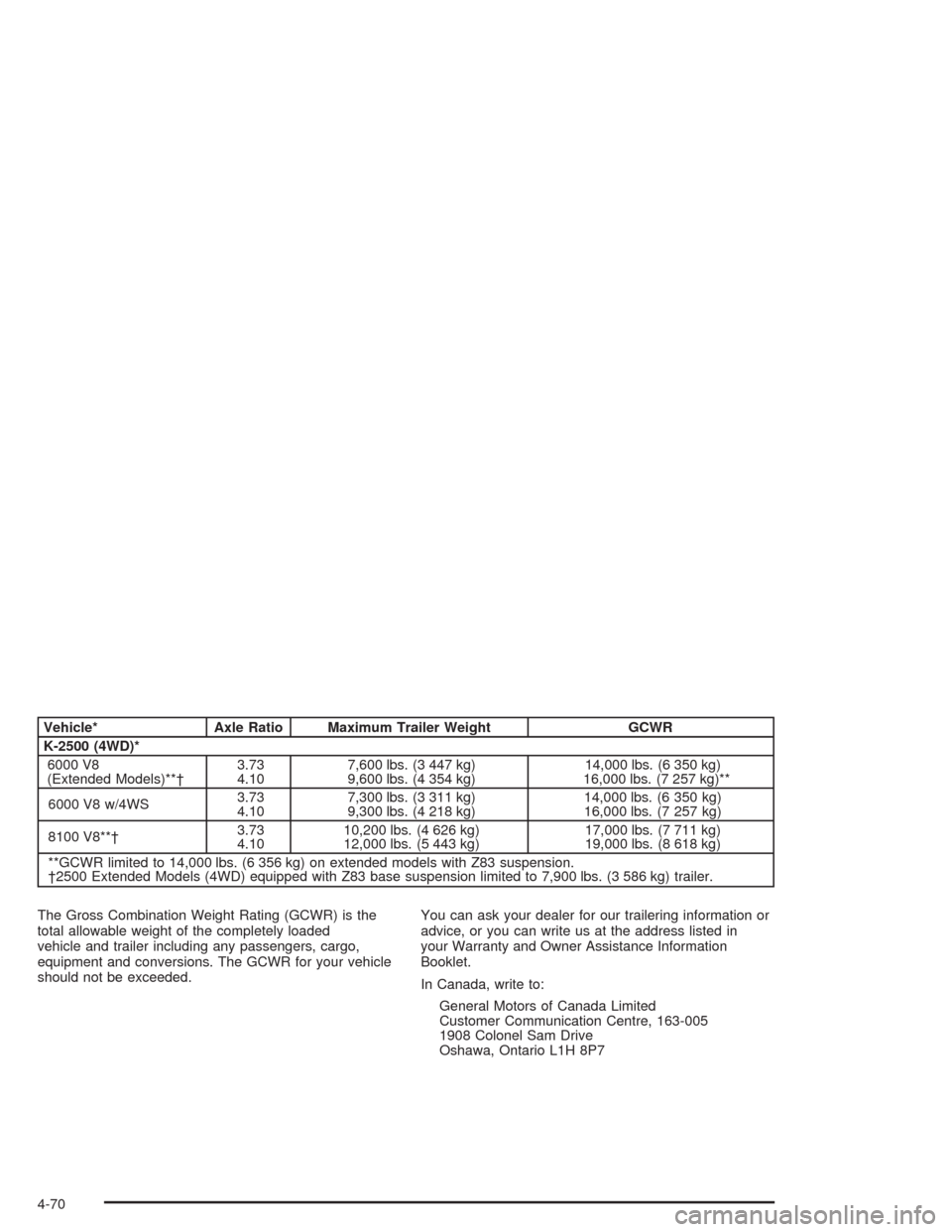
Vehicle* Axle Ratio Maximum Trailer Weight GCWR
K-2500 (4WD)*
6000 V8
(Extended Models)**†3.73
4.107,600 lbs. (3 447 kg)
9,600 lbs. (4 354 kg)14,000 lbs. (6 350 kg)
16,000 lbs. (7 257 kg)**
6000 V8 w/4WS3.73
4.107,300 lbs. (3 311 kg)
9,300 lbs. (4 218 kg)14,000 lbs. (6 350 kg)
16,000 lbs. (7 257 kg)
8100 V8**†3.73
4.1010,200 lbs. (4 626 kg)
12,000 lbs. (5 443 kg)17,000 lbs. (7 711 kg)
19,000 lbs. (8 618 kg)
**GCWR limited to 14,000 lbs. (6 356 kg) on extended models with Z83 suspension.
†2500 Extended Models (4WD) equipped with Z83 base suspension limited to 7,900 lbs. (3 586 kg) trailer.
The Gross Combination Weight Rating (GCWR) is the
total allowable weight of the completely loaded
vehicle and trailer including any passengers, cargo,
equipment and conversions. The GCWR for your vehicle
should not be exceeded.You can ask your dealer for our trailering information or
advice, or you can write us at the address listed in
your Warranty and Owner Assistance Information
Booklet.
In Canada, write to:
General Motors of Canada Limited
Customer Communication Centre, 163-005
1908 Colonel Sam Drive
Oshawa, Ontario L1H 8P7
4-70